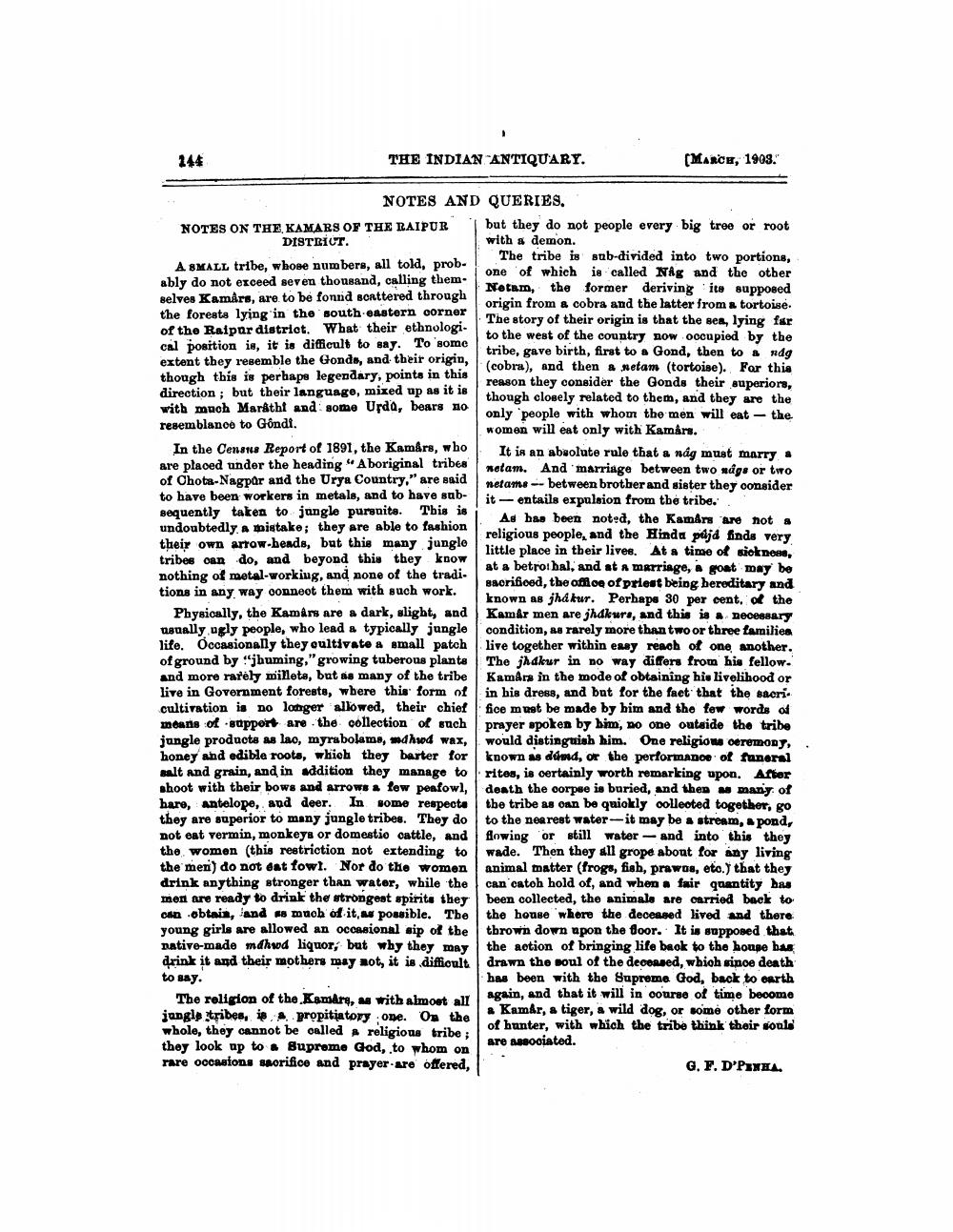________________
244
THE INDIAN ANTIQUARY.
NOTES AND QUERIES.
NOTES ON THE KAMARS OF THE RAIPUR DISTRICT.
A SMALL tribe, whose numbers, all told, probably do not exceed seven thousand, calling them.
selves Kamars, are to be found scattered through
the forests lying in the south eastern corner of the Raipur district. What their ethnologi. cal position is, it is difficult to say. To some extent they resemble the Gonds, and their origin, though this is perhaps legendary, points in this direction; but their language, mixed up as it is with much Marathi and some Urda, bears no resemblance to Gôndi.
In the Census Report of 1891, the Kamârs, who are placed under the heading "Aboriginal tribes of Chota-Nagpur and the Urya Country," are said to have been workers in metals, and to have subsequently taken to jungle pursuits. This is undoubtedly a mistake; they are able to fashion their own arrow-heads, but this many jungle tribes can do, and beyond this they know nothing of metal-working, and none of the traditions in any way connect them with such work.
Physically, the Kamars are a dark, slight, and usually ugly people, who lead a typically jungle life. Occasionally they cultivate a small patch of ground by "jhuming," growing tuberous plants and more rarely millets, but as many of the tribe live in Government forests, where this form of cultivation is no longer allowed, their chief means of support are the collection of such jungle products as lao, myrabolams, mdhud wax, honey and edible roots, which they barter for salt and grain, and in addition they manage to ahoot with their bows and arrows a few peafowl, hare, antelope, and deer. In some respects they are superior to many jungle tribes. They do not eat vermin, monkeys or domestic cattle, and the women (this restriction not extending to the men) do not eat fowl. Nor do the women drink anything stronger than water, while the men are ready to drink the strongest spirits they can obtain, and as much of it, as possible. The young girls are allowed an occasional sip of the native-made mahwd liquor, but why they may drink it and their mothers may not, it is difficult to say.
The religion of the Kamare, as with almost all jungle tribes, is a propitiatory one. On the whole, they cannot be called a religious tribe; they look up to a Supreme God, to whom on rare occasions sacrifice and prayer are offered,
[MARCH, 1903.
but they do not people every big tree or root with a demon.
The tribe is
sub-divided into two portions, one of which is called Nag and the other origin from a cobra and the latter from a tortoise. Netam, the former deriving its supposed The story of their origin is that the sea, lying far to the west of the country now occupied by the tribe, gave birth, first to a Gond, then to a ndg (cobra), and then a metam (tortoise). For this reason they consider the Gonds their superiors, though closely related to them, and they are the only people with whom the men will eat the women will eat only with Kamars.
It is an absolute rule that a nág must marry a netam. And marriage between two nags or two netams -- between brother and sister they consider it
entails expulsion from the tribe.
As has been noted, the Kamars are not a
religious people, and the Hindu pajd finds very little place in their lives. At a time of sickness, at a betro: hal, and at a marriage, a goat may be sacrificed, the office of priest being hereditary and known as jhakur. Perhaps 30 per cent, of the Kamar men are jhdkurs, and this is a necessary condition, as rarely more than two or three families live together within easy reach of one another. The jhakur in no way differs from his fellow. Kamara in the mode of obtaining his livelihood or in his dress, and but for the fact that the sacri fice must be made by him and the few words of prayer spoken by him, no one outside the tribe would distinguish him. One religious ceremony, known as dúnd, or the performance of funeral rites, is certainly worth remarking upon. After death the corpse is buried, and then as many of the tribe as can be quickly collected together, go to the nearest water-it may be a stream, a pond, flowing or still water and into this they wade. Then they all grope about for any living animal matter (frogs, fish, prawns, etc.) that they can catch hold of, and when a fair quantity has been collected, the animals are carried back to the house where the deceased lived and there thrown down upon the floor. It is supposed that the action of bringing life back to the house has drawn the soul of the deceased, which since death has been with the Supreme God, back to earth again, and that it will in course of time become a Kamar, a tiger, a wild dog, or some other form
of hunter, with which the tribe think their souls are associated.
G. F. D'PEXHA




